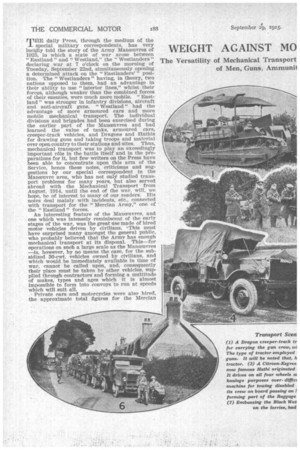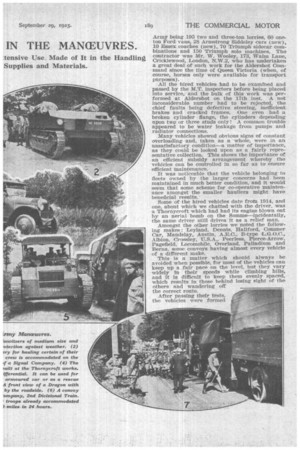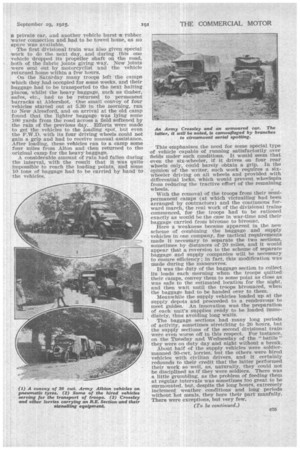WEIGHT AGAINST MO IN THE MANCEUVRES.
Page 16

Page 17

Page 18

Page 19

If you've noticed an error in this article please click here to report it so we can fix it.
METE daily Press, through the medium of the 1special military correspondents, has very lucidly told the story of the Army Manceuvres of 1925, in which a state of war arose between " Eastland " and "Westland," the " Westlanders " declaring war at 7 o'clock on the morning of Tuesday, September 22nd, simultaneously opening a determined attack on the " lilastlanders' " position. The " Westlanders " having, in theory, two nations opposed to them, had an advantage in their ability to use "interior lines," whilst their forces, although weaker than the combined forces of their enemies, were much more mobile. " Eastland " was stronger in infantry divisions, aircraft and anti-aircraft guns. " Westland " had the advantage of more armoured cars and more mobile mechanical transport. The individual divisions and brigades had been exercised during the earlier part of the Manceuvres and had learned the value of tanks, armoured cars, creeper-track vehicles, and Dragons and Eiathis for drawing guns and taking troops and material over open country to their stations and sites. Thus, mechanical transport was to play an exceedingly important role in the battle itself and in the preparations for it, but few writers on the Press have been able to concentrate upon this arm of the Service, hence these notes, criticisms and suggestions by our special correspondent in the Manceuvre area, who has not onlg studied transport problems' for many years, but also served abroad with the Mechanical Transport from August, 1914, until the end of the war, will, we hope, he of interest to many of our readers. Tits notes deal mainly with incidents, etc., connected with transport for the " Mercian Army," one of the " Eastland " forces. An interesting feature of the Manoeuvres, and one which was intensely reminiscent of the early stages of the war, was the great use made of hired motor vehicles driven by civilians. 1This must have surprised many amongst the general public, who probably believed that the Army has enough mechanical transport at its disposal. This—for operations on such a large scale as the Manoeuvres —is, however, by no means the case, for the subsidized 30-cwt. vehicles owned by civilians, and which would be immediately available in time of war. cannot be called upon, and, consequently their place must be taken by other vehicles, supplied through contractors and forming a multitude of makes, types and ages which it is almost impossible to form into convoys to run at speeds which will• suit all. Private cars and motorcycles were also hired, the approximate total figures for the Mercian•
Army being 195 two and three-ton lorries, 60 oneton Ford vans, 28 Armstrong Siddeley cars (new), 10 Essex coaches (new), 70 Triumph sidecar com binations and 150 Triumph solo machines. The contractor was Mr. W. Wooley, 173, Walm Lane, Cricklewood, London, N.W.2, who has undertaken a great deal of such work for the Aldershot Command since the time of Queen Victoria (when, of course, horses only were available for transport purposes).
All the hired vehicles had to be examined and passed by the M.T. inspectors before being placed into service, and the bulk of this work was performed at Aldershot on the 17th inst. A not inconsiderable number had to be rejected, the chief faults being defective steering, inefficient brakes and cracked frames. One even had a broken cylinder flange, the cylinders depending upon two or three studs only ] A common trouble appeared to be water leakage from pumps and radiator connections.
Many vehicles showed obvious signs of constant overloading and, taken as a whole, were in an unsatisfactory condition—a matter of importance, as they could be looked upon as a fairly representative collection. This shows the importance of an efficient subsidy arrangement whereby the vehicles can be controlled in so far as to ensure efficient maintenance.
It was noticeable that the vehicle belonging to fleets owned by the larger concerns had been maintained in much better condition, and it would seem that some scheme for co-operative maintenance amongst the smaller hauliers might have beneficial results.
Some of the hired vehicles date fro fn 1914, and one, about which we chatted with the driver, was a Thornycroft which had had its engine blown out by an aerial bomb on the Somme—incidentally, the same driver still drives it as a relief man.
Amongst the other lorries we noted the following makes Leyland. Dennis, Hallford, Ccrmrner Car, Maudslay, Austin, A.E.C., B-type L.G.O.C., Albion, Crossley, U.S.A., Peerless. Pierce-Arrow, Pagefield, Locomobile. Overland, Palladium and Berna, some convoys having almost every vehicle of a different make.
This is a matter which should always be avoided when possible, for most of the vehicles can keep up a fair pace on the level, but they vary 'widely in their speeds while climbing hills, and it is difficult to keep them evenly spaced, which results in those behind losing sight of the others and wandering off the correct route.
After passing their tests, the vehicles were formed into four companies, which included a proportion of Regular Army vehicles, such as Albions, Crossley tenders, Karriers, Guys, etc.
The system of transport differed considerably at first from that which was described in this journal last year in connection with the divisional exercises, when each R.A.S.C. company looked after supplies or baggage for its units. Actually there were only two "in the field," but this year there were two divisional trains, each comprised of three brigade companies and a divisional troops company, each dealing with supplies and baggage and divided into sections for this purpose, a diamond-shaped plate indicating baggage and a disc supplies, every plate bearing also the number of the division and the name of the particular unit which the vehicle served, so that each of the last-named could easily be identified.
• The elaborate convoy system of indicating discs for " trickling " sub-seetions of three vehicles, with wide gaps between sections to avoid aerial observation, and special discs to indicate the rearmost vehicle of a column or convoy, has not been followed in the case of the " civvy " lorries.
A new scheme was that a unit representative—
usually a private—travelled with each vehicle. In the case of supplies this man had a copy of the demand as sent to the supply officer, and his duty was to check the amount received and lodge a complaint in the event of deficiencies. Each representative was accommodated on his lorry and placed on the ration strength of the R.A.S.C. Coy.
Every unit had its baggage vehicle, and, as in the ease of supplies, a unit representative was carried and saw to the safety of the load.
The four companies of each divisional train were designated A, B, C and D, the triangles and discs for each being coloured red, blue, white and yellow respectively. A Company dealt with baggage and supplies of divisional troops, which are always 70 per cent, of the division. The work of the other three companies was catering for the infantry brigades, there being four battalions in each and requiring one lorry for baggage and one for supplies per battalion. In the case of B, C and D Companies each lorry drew a trailer, thus greatly increasing its load capacity and permitting also the embussing of more troops.
The formation of the. two divisional trains was completed on the Thursday. By that time the civilian drivers had received their equipment, which included knife, fork, spoon, tin mug and plate, two blankets and a waterproof sheet, and, whilst being paid by the contractor, were fed by the Army.
No delay was allowed in putting the trains to useful work, for early on Friday morning the baggage vehicles of the first. divisional train were• ordered to proceed from Aldershot through Odiharn and Basingstoke to West Stratton, there to embus troops who were fatigued after, marching something like 40 miles in the. 24 hours in their, progress towards the concentration area. Rations were sent ahead by a. fast lorry so that the men of the train could have lunch en route. After the embussing the troops were conveyed to the neighbourhood of Droxford, and the baggage colunin then returned to Aldershot, the total time taken being about 13 hours and the mileage approximately 80. Considering that the drivers werb quite new to convoy work, the run was highly successful and little trouble was experienced. There was a smash between an Army Crossley and a private car, and another vehicle burst -a rubber water connection and had to be towed home, as no spare was available.
The first divisional train was also given special work to do the next day, and during this one vehicle dropped its propeller shaft on the road, both of the fabric joints giving way. New joints were sent out by motorcyclist and the vehicle returned home within a few hours.
On the Saturday many troops left the camps which they had occupied for some weeks, and their baggage had to be transported to the next halting places, whilst the heavy baggage, such as timber, safes, etc. had to be returned to permanent barracks a:t Aldershot. One small convoy of four vehicles started out at 5.30 in the morning, ran to New Alresford, and on arrival at the• old camp found that the lighter baggage was lying some 100 yards from the road across a field softened by the rain of the previous day. Efforts were made to get the vehicles to the loading spot, but even the F.W.D. with its four driving wheels could not gain a grip and had to receive manual assistance. After loading, these vehicles ran to a camp some four miles from Alton and then returned to the original camp for the heavy baggage.
A considerable amount of rain had fallen during the interval, with the result that it was quite impossible to reach the loading points, and some 10 tons of baggage had to be carried by hand to the vehicles. • This emphasizes the need for some special type• of vehicle• capable. of running satisfactorily over fields under such conditions. It would seem that even the six-wheeler, if it drives on four rear wheels only, could barely obtain a grip. In the opinion of the writer, such work requires a sixwheeler driving on all wheels and provided with differential locks, which would prevent wheelspin from reducing the tractive effort of the remaining wheels.
With the removal of the troops from their semipermanent camps (at which victualling had been arranged by contractors) and the continuous forward march, the real work of the divisional trains commenced, for the troops had to be rationed exactly as would he the case in war-time and their baggage carried from bivouac to bivouac.
Here a weakness became apparent in the new scheme of combining the baggage and supply
• vehicles in one company, for tactical requirements made it necessary to separate the two sections, sometimes by distances of 20 miles, and it would appear that a reversion to the scheme of separate baggage and supply companies will be necessary to ensure efficiency ; in fact, this modification was made during the manoeuvres.
It was the duty of the baggage section to collect Its loads each morning when the troops quitted' their camps, convey them to some point as close as was safe to the estimated location for the night, and then wait until the troops bivouaced, when the baggage had to be handed over to them. Meanwhile the supply vehicles loaded up at the supply depots and proceeded to a rendezvous to meet guides. An innovation was the preparation of each unit's supplies ready to be loaded immediately, thus avoiding long waits.
The baggage sections had many long periods of activity, sometimes stretching to 20 hours, but the supply sections of the second divisional train were even worse off in this respect For instance, on the Tuesday and Wednesday of the " battle " they were on duty day and night without a break.
About half of the supply vehicles were soldiermanned 30-cwt lorries, but the others were hired vehicles with civilian drivers, and it certainly redounds to their credit that the latter performed their work so well, as, naturally, they could not be disciplined as if they were soldiers. There was a little grumbling, as the problem of feeding them at regular intervals was sometimes too great to be• surmounted, but, despite the long hours, extremely inclement weather conditions and long periods without hot meals, they bore their part manfully. There were exceptions, but very few.
(To be continued.)






























